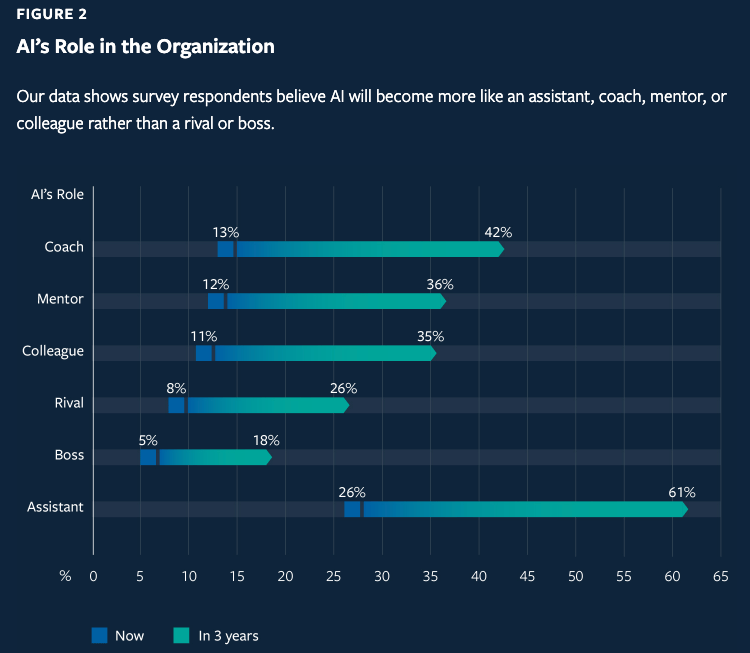- Talent Edge Weekly
- Posts
- Talent Edge Weekly - Issue #324
Talent Edge Weekly - Issue #324
Fast-tracking talent decisions, enabling workforce planning by unlocking trapped capacity, a new agentic AI report, CEO succession planning, and succession metrics.
Welcome to this issue of Talent Edge Weekly!
A shout-out to Ana Reynolds Murillo, Director of Global Talent Acquisition, Employer Branding, & Succession Planning at Yara International, for referring new subscribers to Talent Edge Weekly. Thank you, Ana, for your support of this newsletter!
PRESENTED BY 365Talents
Drowning in spreadsheets to keep job descriptions and job families aligned? Meet 365Talents Job Architect—the specialist HR agent that turns chaos into a clean, governed framework in minutes.
- Visualize your job architecture in real time
- Generate production-ready job descriptions
- Export cleanly to your HRIS
Simple, conversational, and no training needed. Start building your first job framework today.
P.S. Want more help on building your custom skills and job architecture? Speak to a 365Talents expert.
THIS WEEK'S CONTENT
Below are links and descriptions of the topics covered in this issue. If you're interested in my deep dive, you can read the full newsletter.
7 Questions for Fast-Tracking Talent Decisions | Brian Heger | My new cheat sheet with sample questions leaders can use to accelerate timely talent decisions into immediate action.
Strategies for Finding—and Unlocking—the Hidden Potential in Your Workforce | Deloitte Insights | A new article highlights how organizations can unlock “trapped workforce capacity” through tactics such as surfacing hidden skills, reducing low-value work, and leveraging AI and internal mobility.
The Emerging Agentic Enterprise: How Leaders Must Navigate a New Age of AI | BCG and MIT Sloan Management Review | A new 40-page report finds agentic AI is outpacing strategy, prompting leaders to rethink workflows, decision rights, workforce models, and more.
The Pitfalls That Undermine CEO Succession Planning | Harvard Business Review | A new article on 10 common pitfalls in CEO succession planning and how Chief HR Officers and boards can overcome them.
24 Succession Planning Metrics and the Questions They Help Answer | Brian Heger | My succession planning metrics cheat sheet organized by key questions across eight categories.
Also, check out my job cuts tracker & Chief HR Officer move of the week.
👉️ If you’re an internal HR practitioner and want to go beyond reading insights in Talent Edge Weekly and put them into action with me and a curated community of peers, apply now to join my private community, Talent Edge Circle.
⬇️ Now let’s dive in!
THIS WEEK'S EDGE

TALENT MANAGEMENT
My new cheat sheet with sample questions leaders can use to accelerate timely talent decisions into immediate action.
Talent reviews and performance management are critical enablers of organizational performance. Yet a common pitfall is treating these practices as scheduled process events rather than prompts for timely, ongoing, and proactive actions. To help, I’ve created a one-page editable cheat sheet with seven targeted questions that enable leaders and teams to accelerate talent decisions at any moment. For example, Talent Upgrade in a Critical Role: What is one critical role where upgrading the talent in this position would have a significant and positive business impact? What is the role, who is the incumbent, and what is my next step? Hidden Talent: Who is a strong performer whose contributions or potential go largely unrecognized, and what step will I take to increase their visibility? Recognition Need: Who is a valued contributor who may not realize their impact, and whose contributions should be acknowledged now to ensure they feel seen, valued, and engaged? The final column includes editable text boxes that allow leaders to track their decisions and actions in real time, serving as a simplified action plan. Imagine the impact if managers and leaders answered and acted on even one of these questions, let alone several. Use this cheat sheet to make faster, sharper talent decisions.

WORKFORCE PLANNING & ORG EFFECTIVENESS
A new article highlights how organizations can unlock “trapped workforce capacity” through tactics such as surfacing hidden skills, reducing low-value work, and leveraging AI and internal mobility.
One of the topics I wrote about in my book chapter on strategic workforce planning is the challenge of “trapped workforce capacity,” or the talent, skills, and resources that exist within an organization but aren’t fully utilized or reflected in workforce plans. When this capacity is overlooked, it can lead to over-hiring, misaligned resourcing, and missed opportunities to use existing talent more effectively. I’ve also shared several of my one-page cheat sheets, including this one, illustrating how improved ways of working can unlock capacity within the workforce. A new Deloitte article reinforces this point by highlighting how much capacity and capability sit “below the surface” of traditional workforce planning. It outlines several strategies to uncover it, including activating talent marketplaces, leveraging adjacent skills to redeploy workers into in-demand roles, and factoring in digital capacity from AI agents and automation. The article also goes deeper into these tactics with company examples showing how organizations are already putting them into practice. My suggestion for getting started is this: brainstorm where trapped workforce capacity might exist in your organization, narrow the list to the areas with the greatest impact, refine it to what is easiest to tackle, and pick one to address in the next 60 days (ensuring you gain stakeholder alignment and support). Feel free to use my cheat sheet to help identify opportunities.

AGENTIC AI
A new 40-page report finds agentic AI is outpacing strategy, prompting leaders to rethink workflows, decision rights, workforce models, and more.
This new, in-depth report offers a range of considerations, strategies, and tactics for tapping the potential of agentic AI in organizations. While this 40-page report contains more insights than can be covered here, one theme stands out: AI adoption is racing ahead of strategy. Traditional AI adoption is at 72%, genAI at 70%, and agentic AI has reached 35%, with another 44% planning to deploy it. The challenge is that AI is scaling faster than leaders are redesigning processes, decision rights, and workforce models. As a result, the authors note that competitive advantage won’t come from early access to agentic AI (because everyone will have it), but from stronger organizational design around it: how work is structured, how decisions are governed, and how human and AI roles are defined. The report also outlines tactics for making key decisions, such as determining when to bolt AI onto existing workflows for quick wins versus when to redesign entire processes around agentic capabilities. It notes that work design will shift from automating tasks to rethinking workflows; instead of asking “Where can we automate a step?” leaders will ask “Which processes should be rebuilt around human–AI collaboration?” The report also highlights implications for workforce planning, noting that organizations must plan for what work people do, what work agents do, how the two interact, and how both learn over time. As a bonus, here is a new article from McKinsey: HR’s Transformative Role in an Agentic Future.

CEO SUCCESSION PLANNING
A new article on 10 common pitfalls in CEO succession planning and how Chief HR Officers and boards can overcome them.
Succession planning is usually a top priority for most organizations. However, media attention on succession topics involving high-profile companies and executives often heightens awareness, prompting boards to question their own organization’s practices. For example, several media reports this past week noted that Apple is accelerating its succession planning as Tim Cook (CEO for 14 years) may transition from the role as early as next year. As CHROs guide conversations with their boards, a new HBR article highlights 10 pitfalls in CEO succession, based on survey feedback from 49 public directors and interviews with directors, investors, and search consultants. While each pitfall offers useful insights, two stand out: many internal candidates are underdeveloped, lacking the enterprise experiences and stretch roles needed to demonstrate CEO readiness; and boards often conduct only a superficial assessment of external talent, limiting visibility into how internal leaders compare to the broader market. The article shares ideas for overcoming these and other challenges. For those who want to explore the topic further, I’m resharing the more detailed CHRO Association report on which the HBR piece is based. I’m also resharing a Harvard Law School Forum on Corporate Governance article that underscores a board’s responsibilities extending beyond selecting a CEO and highlights the importance of clear communication and stakeholder engagement during the transition.

SUCCESSION PLANNING
My succession planning metrics cheat sheet organized by key questions across eight categories.
As I continue to receive requests for succession planning metrics, here’s my one-page reference outlining sample options. Instead of merely listing the metrics, I’ve started by listing the questions each metric answers. The cheat sheet categorizes 24 metrics into eight areas: Leadership Pipeline, Internal Mobility, Retention and Risk, Development and Performance, Cost and Efficiency, Employee Engagement, Talent Assessment, and Program Effectiveness. For example, under Leadership Pipeline, the question "How many potential successors do we have for each critical role?" is answered by the Bench Strength Ratio, which measures the number of qualified candidates ready to fill critical positions. Similarly, under Retention and Risk, the question "How many critical roles are at risk due to potential retirements?" is addressed by the Retirement Risk Index, which tracks the number of critical positions held by employees nearing retirement age. These metrics are just examples and may not be right for your organization; they’re intended to spark ideas so you can determine which ones, whether on this sample list or not, are most relevant to your needs. Lastly, while individual metrics are important, integrating them into a cohesive narrative that tells the full story of your succession planning efforts can help translate insights into action.
MOST POPULAR FROM LAST WEEK
INTERNAL MOBILITY
My one-page cheat sheet to help managers identify and address behaviors that may unintentionally limit internal mobility within the organization.
JOB CUTS AND LAYOFF TRACKER
Check out my tracker of announcements from a segment of organizations that have conducted job cuts and layoffs since the start of 2023.
A few job cuts announced this past week:
BCE Inc. (NYSE: BCE). The parent company of Bell Canada announced it is cutting nearly 700 jobs (about 650 management roles at Bell and roughly 40 positions at Bell Media) as part of a restructuring effort to better align operations with its growth plan.
International Committee of the Red Cross (ICRC). The humanitarian organization said it will cut 2,900 jobs and reduce its 2026 budget 17% to 1.8 billion Swiss francs ($2.23 billion) amid severe donor fatigue and shifting global priorities.
Nokia Corp. (NYSE: NOK). The company announced a major restructuring that will cut 5,000 additional jobs and consolidate four business groups into two, part of a plan to boost annual operating profit by €1 billion.
CHIEF HR OFFICER MOVE OF THE WEEK
This past week, 9 new CHRO announcements were posted on CHROs on the Go, my subscription platform tracking movement in and out of the CHRO role.
This week’s CHRO move of the week is:
Exelon (CHICAGO, ILLINOIS) [NASDAQ: EXC]—a Fortune 200 company and one of the nation's largest utility companies—announced that Elizabeth (Beth) Pitts-Madonna has been appointed SVP and Chief Human Resources Officer, effective Jan. 1, 2026. She will succeed Denise Galambos, who is retiring at the end of the year after a distinguished 21-year career with the company. Beth joins Exelon from Northrop Grumman, where she most recently served as SVP of Talent, responsible for the company's talent acquisition, leadership development, talent management, and digital HR strategy for nearly 100,000 employees.
‘Read Online’ if email cuts off ✂️
👉️ To access all detailed 9 CHRO announcements from this past week and over 4,500 archived announcements, join a monthly or yearly subscription to CHROs on the Go.
If you are already a subscriber to CHROs on the Go, log in here.
FROM ME ON LINKEDIN
Catch up on what you may have missed from me on LinkedIn:
THE BEST OF OCTOBER 2025
Did you miss the “Best of October ” issue of Talent Edge Weekly? If so, check out issue #321, which includes the most popular resources from the month.
Thank you to TechWolf, who sponsored the Best of October. Learn more about TechWolf’s Work Intelligence Index and how it is helping organizations understand the impact of AI on work tasks.
Want to get your brand, product, or service in front of our active 55,000+ Talent Edge Weekly subscribers? Learn how to become a potential sponsor.
Talent Edge Weekly is written by Brian Heger, a human resources practitioner. You can connect with Brian on LinkedIn and brianheger.com
🗣️ WANT MORE?
Are you an internal HR practitioner?
👉️ Apply for my private, paid community, Talent Edge Circle
Are you a provider of HR-related services?
👉️ Become a sponsor of Talent Edge Weekly
Want to know who’s moving in and out of the CHRO role?
👉️ Join my CHROS on the Go subscription












